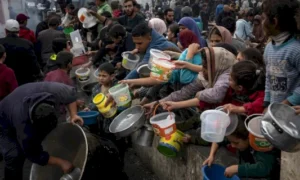Doing Business in the Middle East: Education and Employment in East Jerusalem
challenges, disappointments and despair
By Mounir Kleibo, ILO Representative – East Jerusalem
The Palestinian community in East Jerusalem is characterised by its youth. Data issued by the Palestinian Central Bureau of Statistics (PCBS) shows that the percentage of individuals under 15 years of age in Jerusalem Governorate reached 38.6% in 2010, and the percentage of youth in the 15 – 29 age range was 29%. The total number of students in East Jerusalem schools is 83,066 distributed across 181 schools.
There are five education programmes in the city: the Islamic Waqf schools (governmental), UNRWA schools (for refugees), private schools, and Israeli municipality and Ministry of Education run schools.1 Thus, the education system in East Jerusalem is disjointed, hence making it was rather impossible to address any issues either from a strategic, developmental or technical aspect.
In 2008 /9, the number of students at the community colleges numbered 365 students, and university graduates totalled 1941 students2.
The number of graduates from intermediate community colleges in the same year was 149 students and the percentage of individuals holding a B.A. degree and higher in East Jerusalem was 7.7% in 2011; 6.8% males and 8.6% females3.
Add to this the vocational and technical training system that exists in the city – which stands in no better situation than schools – with weak infrastructure and institutional structure, a lack of qualified, modern human resources capable of coping with the technological and labour-market needs of technical workers. Additionally, for the existing curricula on offer, the programmes and tools currently used do not meet the requirements of Israeli or other local labour markets. In essence, this means that the ability of such centres to serve students is being challenged, and many are not even considering applying to them due to their inability to help them with their training needs.
Unemployment in East Jerusalem
According to the extended definition of unemployment, the unemployment rate in Jerusalem Governorate was 17.9% in 2011. It should be noted that in regards to age groups in this same area, this rate was the highest amongst youths aged between 15 to 19 years, where it hit 35.3% in 2011 for individuals 15 years old and above.4
As for the unemployment rates according to years at school, it is noted that the highest unemployment rate was in 2011 among individuals who studied for 7 to 9 years, with an average of 16.5%.
Challenges in the Labour Market in East Jerusalem:
The Israeli authorities do not provide key services in the fields of education and employment for Palestinians in East Jerusalem, which severely impacts upon the educational system and fails to prepare students with skills that best fit labour market requirements5.
In East Jerusalem, part of the education and higher education system falls within the responsibility of the Israeli Ministry of Education and Municipality. It is subjected to serious negligence, low budgets, over crowding, lack of regular and vocational schools, and lack of classrooms, capacity and facilities.
Students in East Jerusalem schools learn Hebrew as a third language along with Arabic and English, and at times they have to learn a fourth language if they are acquiring their education in private foreign schools (French or German). Graduates of the Arabic educational system under the Palestinian Ministry of Education (i.e. Waqf, governmental, UNRWA and private schools in East Jerusalem) do not learn or practice the Hebrew language, which in turn is a major constraint in facilitating their entering the Israeli labour market, which requires full fluency for day-to-day use.
Many of the Palestinian youths in East Jerusalem attempt to acquire academic titles and vocational training in the West Bank, and even overseas in Arab or European countries or the United States of America. However, if those individuals wanted to step into the Israeli labour market, whether in West Jerusalem or anywhere in Israel, they will have to attend a supplementary completion course, and then do special exams in order to obtain the formal Israeli recognition, or else they will have to hunt for work in the West Bank, where their titles and degrees would be better acknowledged. Some of the disturbing consequences for all this would be the migration or relocation (and thus loss) of those educated and cultured people – raised initially in East Jerusalem – to the West Bank or even abroad.
The enforcement of the strenuous check point procedure and permits to enter Jerusalem has resulted in excluding East Jerusalem from all others6, turning it from a regional city centre that provides services and offers employment opportunities to many West Bankers, into an isolated city which adversely affects its economy, trade, deprives Palestinians of job opportunities, education and health services, including free access to places of worship, let alone the dismantling of family and community ties.
The erection of the security wall surrounding East Jerusalem along 142 kilometers has caused direct losses to the economy in East Jerusalem, estimated at more than a billion US dollars since the initiation of its construction in 2003.
Reduction in consumer demand was a major factor in the closure of more than 280 stores in East Jerusalem over the last 15 years, 50 of them in the old city alone. Other areas located to the North East such as Al-Ram, outside the check point, were also gravely affected due to mobility restrictions, which in turn resulted in the closure of 63 stores out of 110 in Al-Ram Central Market following the construction of the segregation wall (OCHA 2007).
The excessive cost and complex bureaucracy precluded Palestinian businessmen from establishing commercial projects in East Jerusalem.
East Jerusalemites face other impediments as a result of the political situation and the particularity of the East Jerusalem situation, which exacerbated tensions at the outbreak of crises, including in extreme cases, physical harassment and the systematic change for Jewish business owners not to employ Arabs.
Another obstacle, restricted mainly to men, is the requirement of a certificate of good conduct (a police record which states the absence of a criminal past), requested by many Israeli business owners from Palestinian workers as a preliminary condition for employment.
The dire public transport services in East Jerusalem pose another obstacle to any Palestinian working in West Jerusalem, for it only covers Palestinian populated areas and the commercial centre in the old city.
Palestinian women in East Jerusalem are greatly affected by the declining socio-economic status, the lack of educational frameworks for herself and her children, and the scarcity of appropriate jobs. The rate of Palestinian women engaged in the labour market does not exceed 15%; the type of work they perform is usually within the fields of education and office functions in the private sector.
An almost total absence of formal educational frameworks for children, whereby the majority of families cannot afford to enroll their children in private kindergartens due to the excessive tuition fees.
Recommendations
The almost non-existent economy in East Jerusalem, high unemployment rate, poor education system, scarcity of skills, lack of productivity and low wages that do not meet even the minimum standards of sustainability, as well as the lack of an employment policy for the city for the intermediate (or even short or long term!) are not conducive with reducing poverty and achieving sustainability for its main victims – the youth.
There is still a lot to be done to decrease dropping out of school through preventive intervention. Those who leave school at an early stage represent an important category of deprived youth.
Gender gaps still exist in all aspects of the youth unemployment crisis. All policies must include a prospective that differs with the difference in gender, and they should be incorporated with wider scoped policies to promote gender equality.
Programmes aimed at promoting project organisation amongst youth could contribute greatly to increasing job opportunities. The limited funding for small and medium enterprises, which has been affected negatively by the current global crisis, requires great attention through financial reforms and reforms to the economy as a whole.
Vocational and technical training and education systems should respond to the fast and increasing changes in the demand for skills.
Finally, a youth unemployment crisis of this scale and under these specific conditions can only be faced through coordination and partnerships at the local, regional and global levels, including international financial organisations and other multilateral organisation, regional organisations and the UN.


























